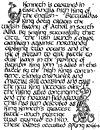On November 4, 1993 the Lion's Den began the DBA campaign prepared by Ken. We playtested the rules and demonstrated the various army list combinations until the general consensus was that everyone was familiar with the rules.
Late in the evening, and despite the fact one player was absent, we began the campaign. The players chose their armies as follows: Ken played Anglo-Danes, the Welsh army no one spoke for so it was left for Doug. John wanted to play Irish, our new member Dave wanted to play the Scots, Mark decided early on playing Vikings, and James said he guessed he would command the Normans. An enlarged color version of our map was brought out along with all of the necessary map pins and play began.
Command Figure
One PUB I had tried to introduce was the concept of a separate command figure. The idea was to represent each army general with a separate mounted Essex miniature. To locate the army on the campaign map, simply place the general on the province or city they occupied. This worked well as an indicator of army placement.
Where the confusion started was when the army was on the battlefield in a game. I intended to have each player indicate which element the general accompanied by placing the general directly behind said unit. This tended to become a little vague because of the space limitations. There is no place in the rules of DBA for this practice, and it was only supposed to be decorative anyway. We finally settled on Xing the underside of the generals stand and the single mounted figure became a symbolic artifact on the field. I still like the idea and use it in my battle games.
The game got under way quickly and we started the campaign date as Spring 1066 to allow alliances to form and to establish the reign of Edward the Confessor. The Welsh enjoyed a year of unhistorical peace since it was considered oppurtunistic to sedge a man's territory while he wasn't there to defend it. This meant that the only other threat to the Anglo-Danes were the Scots. Dave decided to kick off the campaign with the invasion of Danish Mercia. He received his share of the first years fighting, only to be forced back to his capital in the ensuing Anglo-Dane counter attack -
Many battles and alliances occurred over the two evenings of wargaming in the Lion's Den. We had preset the number of campaign years at five. This gave us the time span of 1066 thru 1070, to gather as much prestige and territory as possible.
Rather than recount the blow by blow account of the entire proceedings here, I will include in this Whistle an excerpt from the Anglo Saxon War Chronicle I penned to commemorate the canpaign. It is a biased account, and gives only one nations view of the era and activities, but it certainly livened up the battle games.
Stick That in Your Chronicle
I remember vivid taunts and jeers during battles in which the Anglo-Danes were taking a beating. "Stick that in your chronicle", became the punctuating war cry of the Vikings after a successful die roll. The written record of a wargame campaign is worth the effort. It gives history to the proceedings and perspective to the players.
The title of High King goes to Doug the commander of the Welsh! In the final round of the year 1070, Doug has accumulated 23 prestige points. The Welsh prestige was gained primarily as an allied contingent on the battlefield. Along with his territorial gains, Doug leads the game by 3 points. The next closest competitors for the crown were Ken (20 prestige) and Mark (20 prestige), the Kings of the Anglo-Danes and Vikings respectively. Followed in descending order; Irish, Norman, Scot. In this era the crown of the Bretwalda is in the hands of a mercenary captain.
Back to Table of Contents Penny Whistle #2
Back to Penny Whistle List of Issues
Back to MagWeb Master Magazine List
© Copyright 1993 by Lion's Den Publications.
This article appears in MagWeb (Magazine Web) on the Internet World Wide Web.
Other military history articles and gaming articles are available at http://www.magweb.com
